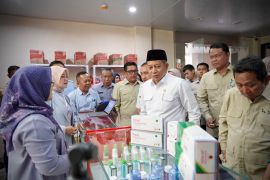Nevertheless, UNICEF regretted that about 150,000 Indonesian children are still likely to die every year before celebrating their fifth birthday.Jakarta (ANTARA News) - Infant mortality rate in Indonesia decreased significantly over the last 25 years, falling from 84 deaths per thousand births in 1990 to just 27 deaths per thousand births in 2015, UNICEF has said.
Infant and under-5 mortality rates in Indonesia have halved since 1990, thanks to continued investment in health care.
"Saving the lives of millions in the past 25 years is a great achievement for Indonesia," UNICEF Representative Indonesia Gunilla Olsson said in a written statement on Wednesday.
According to the latest report of the UNICEF Global, this decline has saved more than five million Indonesian children who might have died if the mortality rate had remained at the 1990 level.
A total of 395,000 children in Indonesia in 1990 were estimated to have died before the age of 5 years, while this year, the number was reduced by 147,000 children.
Nevertheless, UNICEF regretted that about 150,000 Indonesian children are still likely to die every year before celebrating their fifth birthday.
But on the other hand, there is high disparity in Indonesia with data showing that the child mortality rate in Papua is three times higher than that in Jakarta.
"Almost half of under-5 deaths occur within the first month after birth and can be attributed to complications of premature birth and severe infection," says Gunilla.
Indonesian children are still facing fears of growing stunted due to excessive nutritional deficiency and also poor child health. Poor sanitation is also a reason as about 52 million people in Indonesia practice open defecation.
To bring down child mortality further, the simple solutions with minimal costs include expanding the reach of immunization, supplementing vitamin A, exclusive breastfeeding and providing appropriate treatment for common diseases.
According to Gunilla, provision of oral re-hydration or electrolyte fluid and iron for diarrhea and the use of new vaccines that have not been introduced in Indonesia so far can reduce mortality rate in the long term.
In addition, UNICEF noted that the progress in reducing maternal mortality has been slower, however, with an estimated 17,000 women still losing their lives every year due to complications during pregnancy and childbirth.
Many infants are left unprotected against disease because of low levels of breastfeeding -- less than half of Indonesian children are exclusively breasted for the first six months of life.
It is necessary to ensure that mothers understand the long-term benefits of the important practice of breastfeeding for the survival and development of their children.
Exclusive breastfeeding for the first six months of an infants life can not only improve their future growth and educational achievement, but also significantly reduce national health costs and help prevent chronic malnutrition.
According to some studies, breast milk provides the ideal nutrition for infants because it has a nearly perfect mix of vitamins, protein, and fat -- everything the baby needs to grow.
Breast milk contains antibodies that help a baby fight off viruses and bacteria, and thus, breastfeeding lowers a babys risk of having asthma or allergies.
Moreover, only 37 per cent of children aged between 6 and 23 months are fed according to recommended practices.
One key protection for all children -- the right to an identity -- is also lacking for many Indonesian youngsters. Only around 57 per cent of children under age 5 have an official birth certificate.
Mothers are at risk from preventable deaths in pregnancy and childbirth.
While the number of women receiving ante-natal care has increased in recent years, more than half of all deliveries still take place at home without specialist facilities on hand to deal with complications.
More needs to be done to improve standards of care, in both public and private sector facilities and among health care workers.
While Indonesia has set a goal of three-quarters of children up to the age of 6 benefiting from early childhood education, today less than half of these children can access such services.
Early childhood education is recognized as important for a childs overall growth and development, and improves their preparedness for school later in life.
Data shows that behind improvements in national statistics, there are clear geographical and socio-economic disparities that affect Indonesias youngest citizens.
For example, the infant mortality rate in East Nusa Tenggara province is 58 deaths for every 1,000 live births, almost double than that of Yogyakarta province and much higher than the national rate of 40 deaths.
Under-five and infant mortality rates among the poorest households are generally more than twice those in the highest income families.
There is a 17 per cent difference between the number of women in urban and rural areas who have a trained health worker attending to them during childbirth.
More than 68 per cent of the lowest income mothers give birth at home, compared to just 12 per cent among the richest families.
Evidence points to a divide in early childhood education services between the poorest and wealthiest families. While almost three quarters of children aged 5 or 6 from the wealthiest households attend pre-primary or primary school, less than half of those from the poorest families do so.(*)
Reporter: Otniel Tamindael
Editor: Heru Purwanto
Copyright © ANTARA 2015










